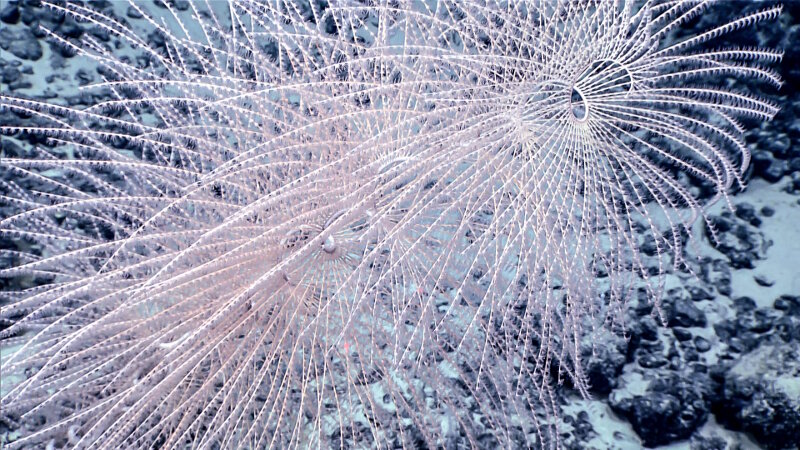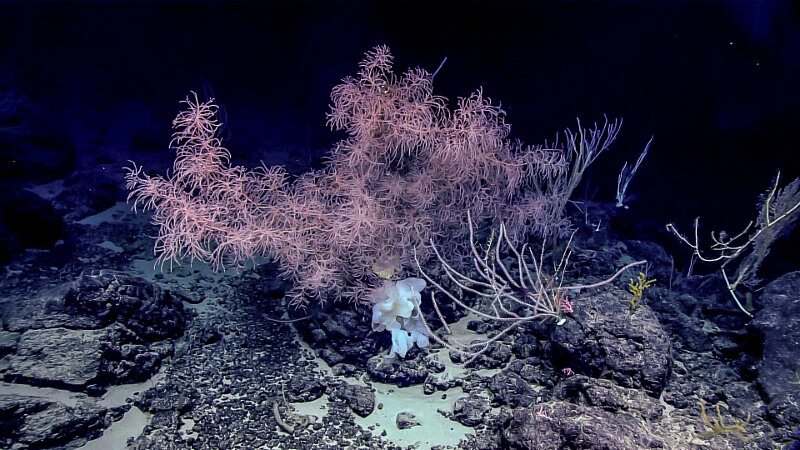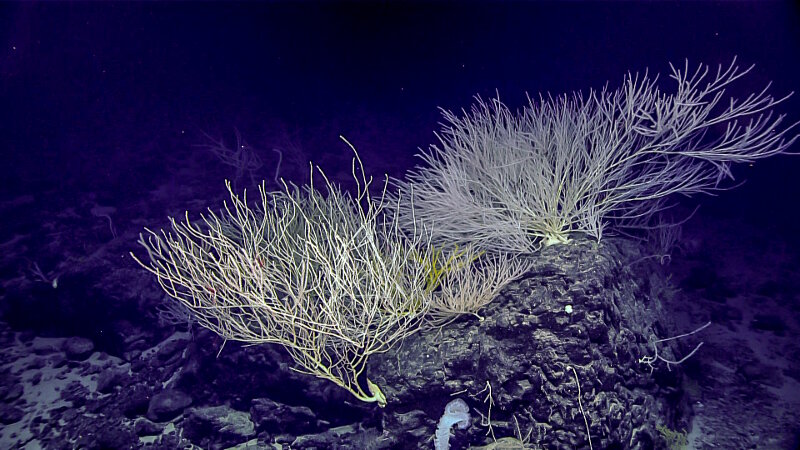
By Bryan Costa - NOAA National Centers for Coastal Ocean Science
Matt Poti - NOAA National Centers for Coastal Ocean Science
Laurie Bauer - NOAA National Centers for Coastal Ocean Science
September 15, 2017

Large cology of Iridogorgia magisprialis, an octocoral in the family Chrysogorgiidae. The spiraling main axis of this coral helps increase the surface area and food supply to the coral’s polyps. Image courtesy of the NOAA Office of Ocean Exploration and Research, Deep-Sea Symphony: Exploring the Musicians Seamounts. Download larger version (jpg, 2.2 MB).
The exploration of remote, deep-sea locations can be expensive and logistically challenging. Habitat suitability modeling has become a cost-effective tool to help researchers and resource managers prioritize areas and maximize the utility of future deep-sea mapping and exploration efforts.

Dense and diverse coral community at “Tropic of Cancer” Seamount with large Iridogoria sp. (center), bamboo coral (foreground and background), black coral (right), pink coral (right), and glass sponges (lower middle). Beautiful “bamboo forest” of Isididae coral on an outcrop at “Tropic of Cancer” Seamount. Image courtesy of the NOAA Office of Ocean Exploration and Research, Deep-Sea Symphony: Exploring the Musicians Seamounts. Download larger version (jpg, 2.2 MB).
Over the past several years, NOAA National Centers for Coastal Ocean Science (NCCOS) has developed regional models predicting the relative suitability of seafloor habitats for deep-sea corals. These types of regional models were recently developed for the Main Hawaiian Islands (MHI), in partnership with the Bureau of Ocean Energy Management. They predict and depict the relative likelihood of finding suitable habitat for deep-sea corals groups at discrete locations around the MHI. Locations are more likely to contain suitable habitat if they have similar environmental and oceanographic conditions as other places where deep-sea corals have been observed in the past.
Since these maps are predictions, it is important to evaluate their utility independently when and wherever possible. On September 7, the NOAA Office of Ocean Exploration and Research’s Deep-Sea Symphony expedition aboard NOAA Ship Okeanos Explorer provided NCCOS an opportunity to evaluate their deep-sea coral predictions in the MHI using a remotely operated vehicle (ROV).

Example of a habitat suitability model for deep-sea corals in the family Paragorgiidae (pictured top left) in the Main Hawaiian Islands Exclusive Economic Zone. a) Red crosses represent observations of Paragorgiidae used to generate the model. c) Inset depicting the Tropic of Cancer Seamount. The black line denotes the ROV trackline. Warm colors (e.g., red) denote areas predicted to be more likely to contain suitable coral habitat and cooler coolers (e.g., blue) denote areas predicted to be less likely to contain suitable coral habitat. Image courtesy of the NOAA Office of Ocean Exploration and Research, Deep-Sea Symphony: Exploring the Musicians Seamounts. Download larger version (jpg, 2.1 MB).
ROV Deep Discoverer was deployed on the “Tropic of Cancer” Seamount northwest of the island of Oahu. Several of our models identified this seamount as being very likely to have suitable habitat for several groups of deep-sea corals, including Paragorgia, Calcaxonia, Isididae, and other Gorgonian Alcyonacea. On one of the seamount’s ridges, the ROV explored and documented a dense and diverse deep-sea community, including Paragorgia, Calcaxonia, Isididae, Gorgonian Alcyonacea, Non-gorgonian Alcyonacea, Scleraxonia, Antipatharia, and Pennatulacea.
The underwater video (and high-resolution seafloor imagery) collected by the Okeanos Explorer will help inform NCCOS’s habitat suitability models in a couple critical ways. First, this data can be used to understand whether these models can successfully predict habitat suitability (or lack of suitability) for locations without any previous deep-sea observations. The “Tropic of Cancer” Seamount was once such place, as it did not have any modern-day records describing its deep-sea communities. NCCOS’s models successfully predicted high relative habitat suitability for several deep-sea coral groups observed during this ROV dive, including Paragorgia, Calcaxonia, Isididae, and other Gorgonian Alcyonacea.

Beautiful “bamboo forest” of Isididae coral on an outcrop at “Tropic of Cancer” Seamount. Image courtesy of the NOAA Office of Ocean Exploration and Research, Deep-Sea Symphony: Exploring the Musicians Seamounts. Download larger version (jpg, 1.9 MB).
Second, regional models (that did not perform as well in this location) could be refined using this suite of information. Models may not correctly predict deep-sea coral distributions for a number of reasons, including missing or very coarse environmental information and old or uncertain deep-sea coral records. NCCOS’s regional models faced similar challenges and data limitations in the MHI.
The new, high-resolution ROV video and seafloor imagery collected by the Okeanos Explorer mitigates some of these challenges, and could be used to create new, more highly resolved and sophisticated models for the “Tropic of Cancer” Seamount (and other similarly mapped areas). Continuing to expand our knowledge of deep-sea coral habitats, through data acquisitions like those done by the Okeanos Explorer and regional models like those created by NCCOS is critical to understanding these ecologically and economically important deep-sea communities.